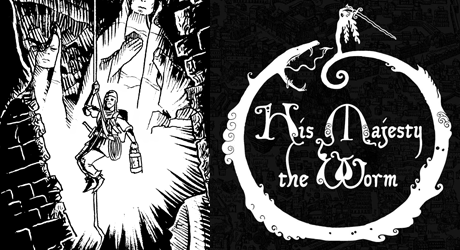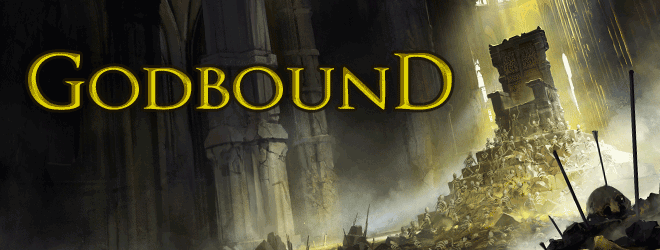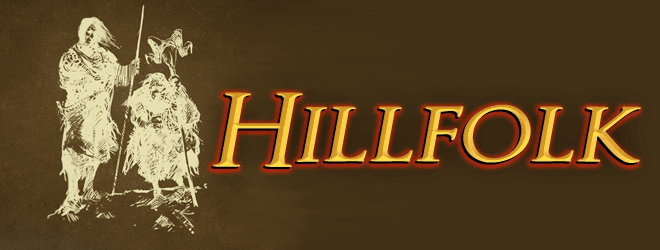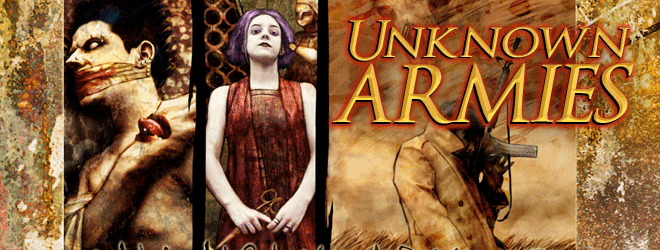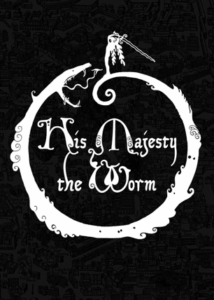 In June 2025 we presented the His Majesty the Worm Bundle featuring His Majesty the Worm, a new-school megadungeon-crawling RPG from Josh McCrowell at Rise Up Comus. The Underworld blasphemes the earth under the City at the center of the world. You and your guild-mates have personal quests that compel them to step through the gate into those lightless depths. If you fulfill your quests, you can finally retire. Until then – in the cycle of descent, exploration, return, restock, rest – all that protects you is your Bonds of loyalty, rivalry, mentorship, and even love. Play them to the hilt, and you might survive.
In June 2025 we presented the His Majesty the Worm Bundle featuring His Majesty the Worm, a new-school megadungeon-crawling RPG from Josh McCrowell at Rise Up Comus. The Underworld blasphemes the earth under the City at the center of the world. You and your guild-mates have personal quests that compel them to step through the gate into those lightless depths. If you fulfill your quests, you can finally retire. Until then – in the cycle of descent, exploration, return, restock, rest – all that protects you is your Bonds of loyalty, rivalry, mentorship, and even love. Play them to the hilt, and you might survive.
Definitions of “new school” range all over the place, but in His Majesty the Worm Josh uses it to mean “the classic megadungeon experience given fresh life through a focus on the mundanities and small moments of daily life inside the dungeon. Food, hunger, light, and inventory management are central to play and actually fun.” Josh cites as influences comics like Rat Queens (Image Comics 2013-23) and the Japanese manga Dungeon Meshi [Delicious in Dungeon], films like Labyrinth and Cube, books including House of Leaves, Invisible Cities, Susanna Clarke’s Piranesi, and The Tombs of Atuan, and tons of OSR blogs. The thinking behind His Majesty the Worm may remind you of Shadowdark or Mythic Bastionland. That was parallel convergent evolution; all three games grew independently for years before their publications, and Worm may be the eldest.
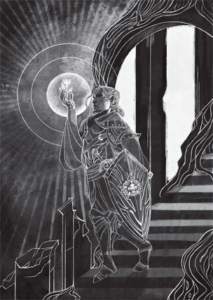 Josh worked on His Majesty the Worm for eight years, writing methodically every Sunday, funding the effort by selling ashcan chapters one by one on itch.io. (On a Reddit r/rpg Ask Me Anything last August, he said, “You can collect pennies from the couch cushions by putting up PWYW products and, once you hit a milestone, hire artists one picture at a time.”) He marketed the evolving game through social media and frequent Comus blog posts. He shopped the finished 400-page book to Exalted Funeral, which split the printing costs with him. The first printing sold out in three hours.
Josh worked on His Majesty the Worm for eight years, writing methodically every Sunday, funding the effort by selling ashcan chapters one by one on itch.io. (On a Reddit r/rpg Ask Me Anything last August, he said, “You can collect pennies from the couch cushions by putting up PWYW products and, once you hit a milestone, hire artists one picture at a time.”) He marketed the evolving game through social media and frequent Comus blog posts. He shopped the finished 400-page book to Exalted Funeral, which split the printing costs with him. The first printing sold out in three hours.
With its old-school stylings – simple systems, rulings not rules, traps as puzzles, environmental dangers, challenges with no thought for balance – it’s all in the game’s devlog manifestos – what makes His Majesty the Worm interesting?
Your adventurer has a kith (human, fay, Underfolk, orc) that grants a talent; four attributes (Swords, Cups, Wands, and Pentacles), each rated 1-4; a quest (a reason to enter the Underworld); and some motifs, short descriptors that define a moment in your backstory. You may have animal companions, but you don’t have hirelings, because you’re someone else’s hireling, heading underground to fulfill a guild contract. You have gear that encumbers you based on slots; your belt has four slots for gear, and your pack has 21 more.
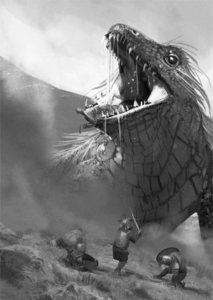 Above all, you have Bonds, relationships with other members of your guild (player characters) such as Best Friend, Mentor/Mentee, Rival, Sibling, Ward, or even Unrequited Love or Adversary. The systems in His Majesty the Worm heavily emphasize roleplaying your Bonds in your adventures from the City to the Underworld beneath.
Above all, you have Bonds, relationships with other members of your guild (player characters) such as Best Friend, Mentor/Mentee, Rival, Sibling, Ward, or even Unrequited Love or Adversary. The systems in His Majesty the Worm heavily emphasize roleplaying your Bonds in your adventures from the City to the Underworld beneath.
The Game Master uses a tarot deck to randomly generate City locations and dungeons, or you can connect multiple existing dungeons for your Underworld. Each play sequence in His Majesty the Worm consists of a Crawl Phase where you explore the Underworld, interspersed with tactical Challenge Phases; then a Camp Phase; and finally a City Phase that resolves the sequence.
- In the Crawl Phase you charge your Bonds with guild-mates through roleplaying. The rules attend carefully to torches, marching order, mapping, standing watch, stealth and noise, checking for traps and secret doors, and so on. The “Meatgrinder” system uses card draws from a tarot deck to determine when torches gutter, when events test your resources, or when random encounters lead to Challenges.
- Challenges use your character’s attributes. In a “test of fate” you draw a minor arcana card (numbered 1-14) and add the associated attribute; 14+ is a success. You have Resolve points you can spend to increase the result, and your motifs or other factors can impose favor (+3) or disfavor (-3). If you succeed and the drawn card’s suit matches the attribute being tested, that’s a “great success.” You can also “push fate” by drawing a second card; if the combined total still fails, that’s a “great failure.” Challenge results can impose many effects like Blind, Controlled, Grow/Shrink, Inspired, Root (immobilize), and so on; an attack on an item may bring a Notch effect, a certain number of Notches destroys the item.
- In a combat Challenge, each player draws four tarot cards. Card play determines a character’s position in initiative order, as well as the target number an attacker must beat to hit the character. All players have interesting choices throughout the battle and can play cards out of turn. The suit of your card (Swords, Wands, Pentacles, Cups) determines the kind of actions you can take; there are also miscellaneous actions that can use any card. A successful attack inflicts a Notch on your armor or a condition such as Staggered, Injured, or (eventually) Death’s Door. If you die in the Underworld, you rise later as a zombie.
- In Camp you consume rations, hunt, fletch arrows, scout around, or burn charged Bonds to heal wounds and regain Resolve.
- Back in the City, you pay half your gold to the All-Watch in taxes, spend your remaining loot at the Omphalic Market to replenish your gear, spread news of your deeds to gain Fame, turn in completed contracts to gain experience (funerals for slain comrades can also give experience), train, research, etc. You can also build a permanent structure that costs “50 gold per syllable of the building’s description.” (“A bar” is cheap. “Gargoyle statue that taunts the mayor” costs way more.) Or you can carouse (spend gold to gain experience) – though then you roll on the Hangover Table to see if you wind up robbed or tattooed or in a cult or married.
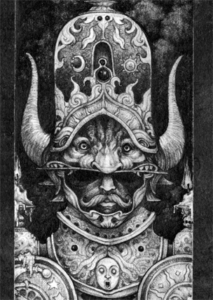 What else? The lengthy Worm rulebook includes sorcery spells, alchemy rules, a bestiary, and (the longest sections) detailed systems for generating the City and the Underworld. Through an Open License, third-party indie designers are publishing His Majesty the Worm community supplements at The Library Heretical.
What else? The lengthy Worm rulebook includes sorcery spells, alchemy rules, a bestiary, and (the longest sections) detailed systems for generating the City and the Underworld. Through an Open License, third-party indie designers are publishing His Majesty the Worm community supplements at The Library Heretical.
 The .PDF rulebook in this all-new His Majesty the Worm Bundle showed why the Exalted Funeral His Majesty the Worm hardcover sold out in three hours. Along with the complete non-watermarked, DRM-free His Majesty the Worm, this offer included the cozy halfling-village game Under Hill, By Water and its travel expansion Walking Holiday.
The .PDF rulebook in this all-new His Majesty the Worm Bundle showed why the Exalted Funeral His Majesty the Worm hardcover sold out in three hours. Along with the complete non-watermarked, DRM-free His Majesty the Worm, this offer included the cozy halfling-village game Under Hill, By Water and its travel expansion Walking Holiday.
Designing Dungeons
His Majesty the Worm designer Josh McCrowell has a free tutorial course, Designing Dungeons: Or, How to Kill a Party in 30 Rooms or Less. This series of discussions, practical examples, and exercises is designed to walk new Game Masters through the process of creating a dungeon from scratch. Using a hands-on approach, the course demystifies the process of dungeon design. Follow along and you’ll construct a dungeon for your players to explore.
